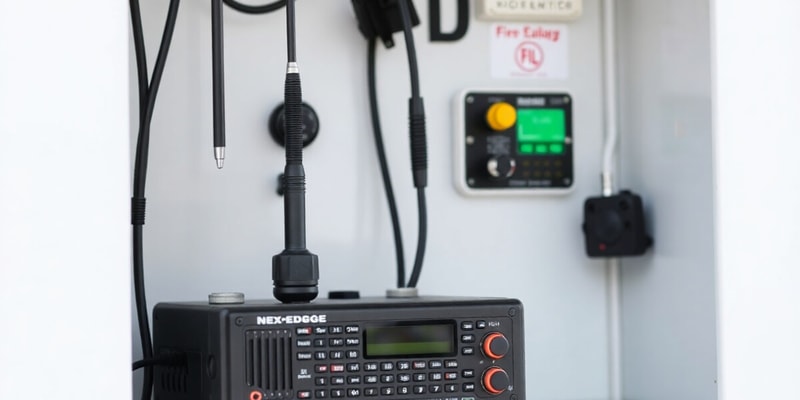Podcast Beta
Questions and Answers
Who is authorized to use the Spring Fire Department radios?
What must be used when a department vehicle equipped with headsets is in operation?
Which organization regulates radio communications in the United States?
What should be done during high call volume regarding radio traffic?
Signup and view all the answers
Which channels are not monitored unless a working incident is assigned?
Signup and view all the answers
What is the purpose of the Standard Order Model in radio communications?
Signup and view all the answers
What channel do units switch to for all incident communications?
Signup and view all the answers
What is emphasized as important for the use of the radio?
Signup and view all the answers
What does 'Priority Traffic' refer to in incident communications?
Signup and view all the answers
Who may use Spring Fire Department radios for on-scene communications?
Signup and view all the answers
What does the term '99 Bravo' signify?
Signup and view all the answers
What is the role of the dispatcher during a critical incident?
Signup and view all the answers
What does the 'References & Related Policies' section include?
Signup and view all the answers
Who is the appropriate contact for questions regarding the SOG?
Signup and view all the answers
What can a violation of this policy lead to?
Signup and view all the answers
Which of the following is NOT a reason this policy should not be construed as a legal duty?
Signup and view all the answers
What is the primary function of the EMS Operations Channel (COM 1)?
Signup and view all the answers
Which channel is specifically designated for low acuity incidents?
Signup and view all the answers
What is a key characteristic of Tactical Channels (COM 6 - 18)?
Signup and view all the answers
How must units communicate before transmitting messages on the radio?
Signup and view all the answers
Which operational channel is primarily focused on outgoing transmissions without talk-in?
Signup and view all the answers
What type of incidents are Tactical Channels typically used for?
Signup and view all the answers
Who may request whether a tactical channel is monitored?
Signup and view all the answers
What is the protocol if a message is misunderstood during radio communication?
Signup and view all the answers
Study Notes
Radio Communications
- Only Spring Fire Department members can use department radios, unless authorized by the Fire Chief or designee.
- Headsets are required when department vehicles equipped with headsets are moving, operating, or being used by personnel.
- The Federal Communications Commission (FCC) regulates all radio communications in the United States.
UHF Digital NexEdge Radio System
-
COM 1: EMS Operations Channel:
- Patched with ESD 11-4(7/800)
- Monitored by dispatchers constantly
- Used for general EMS operational radio traffic (units going in route, in service), on-scene operations, and communications with dispatch
- Can handle multiple EMS incidents simultaneously.
-
COM 2: Fire Dispatch Channel:
- Monitored by dispatchers constantly.
- Primarily used for outgoing transmissions, no incoming traffic allowed.
-
COM 3: Operations Channel:
- Monitored by dispatchers constantly.
- Used for low acuity incidents and general operational radio traffic (units going enroute, in service, etc.), on-scene operations, and communications with dispatch.
- Multiple incidents can run simultaneously on this channel.
-
Tactical Channels (COM 6-18):
- Not monitored by dispatch unless a working incident is assigned.
- Used for high acuity/critical incidents, such as structure fires, MVC entrapments, and aircraft emergencies.
- Can be requested by the Incident Commander to be monitored or not monitored.
- Only one incident per channel allowed unless in extraordinary circumstances.
- One dispatcher will monitor the tactical channel during critical incidents.
Operations and Radio Traffic Discipline
- No simulcast between Fire Dispatch, Operations Channels, and/or Tactical Channels.
-
Standard Order Model:
- When ready to transmit, the sender calls the receiver to check readiness.
- Receiver acknowledges the sender.
- Sender transmits the message after receiving acknowledgement.
- Receiver re-states the message for confirmation and acknowledges receipt.
- Sender restates the message if it's misunderstood.
- Field units call in incidents on COM 3: Operations Channel.
- Dispatch directs units to remain on Operations Channel or switch to the appropriate Tactical Channel.
- Units monitor Fire Dispatch Channel for incident notifications.
- Units switch to directed Operations or Tactical channels for all incident communications once dispatched.
- All enroute traffic occurs on Operations Channel or assigned Tactical Channel.
-
Emergency Traffic:
- Used by the Incident Commander to relay important and urgent information to Dispatch.
-
Priority Traffic:
- Used by those operating in the hazard zone to relay important and urgent information to the Incident Commander.
-
99 Bravo:
- Used when a personnel unit believes they are in danger, cannot retreat to safety, and cannot provide details on the radio without further jeopardizing their safety.
- The dispatcher stays dedicated to the critical incident until it's declared under control.
References & Related Policies
- NFPA, applicable State or Federal Statutes, OSHA, Spring FD, TCFP, CPSE PI, ISO, and TFCA.
Studying That Suits You
Use AI to generate personalized quizzes and flashcards to suit your learning preferences.
Related Documents
Description
This quiz covers the regulations and protocols surrounding radio communications within the Spring Fire Department and the specific UHF Digital NexEdge Radio System. It highlights operational channels, monitoring procedures, and essential communication guidelines. Test your understanding of the rules governing emergency radio usage.




